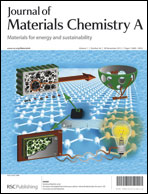A promising anchor group for efficient organic dye sensitized solar cells with iodine-free redox shuttles: a theoretical evaluation†
Abstract
The advantages and disadvantages of a new anchor group 2-(1,1-dicyanomethylene)rhodamine (DCRD) in D–π–A dyes for dye sensitized solar cells, compared with the commonly used anchor group cyanoacrylic acid (CA), were firstly investigated through DFT/TDDFT calculations on the dye/(TiO2)48/electrolyte interfacial electronic dynamics. It was found that the dissociative bidentate bridging mode is the most stable adsorption configuration on the TiO2 anatase (101) surface for DCRD. The calculated results indicate that in contrast to dyes with a CA group, the DCRD anchor group-based dye has a red-shifted absorption spectrum, which is beneficial for the enhancement of Jsc. However, the S atom in the DCRD group near the semiconductor surface has strong interactions with I2, which could lead to a higher I2 concentration in the vicinity of the dye-coated TiO2 surface, accelerating interfacial charge recombination. To avoid such shortcomings, a further optimization strategy for DCRD-based dyes was also proposed from a theoretical point of view. More importantly, we anticipate that dyes with the DCRD anchor group could show better performance in iodine-free redox shuttles-based DSSCs, in which the dye–I2 interaction could be avoided.


 Please wait while we load your content...
Please wait while we load your content...